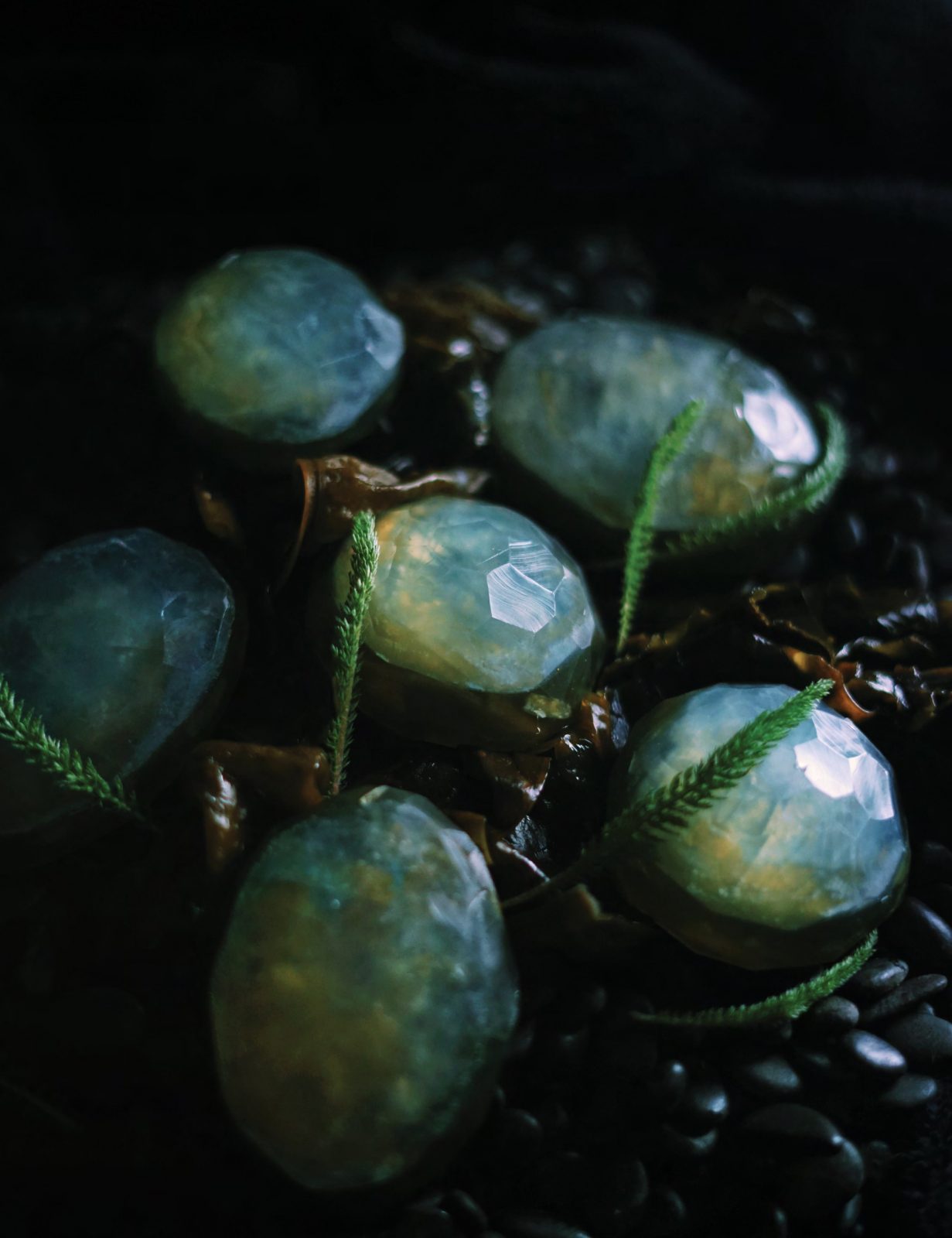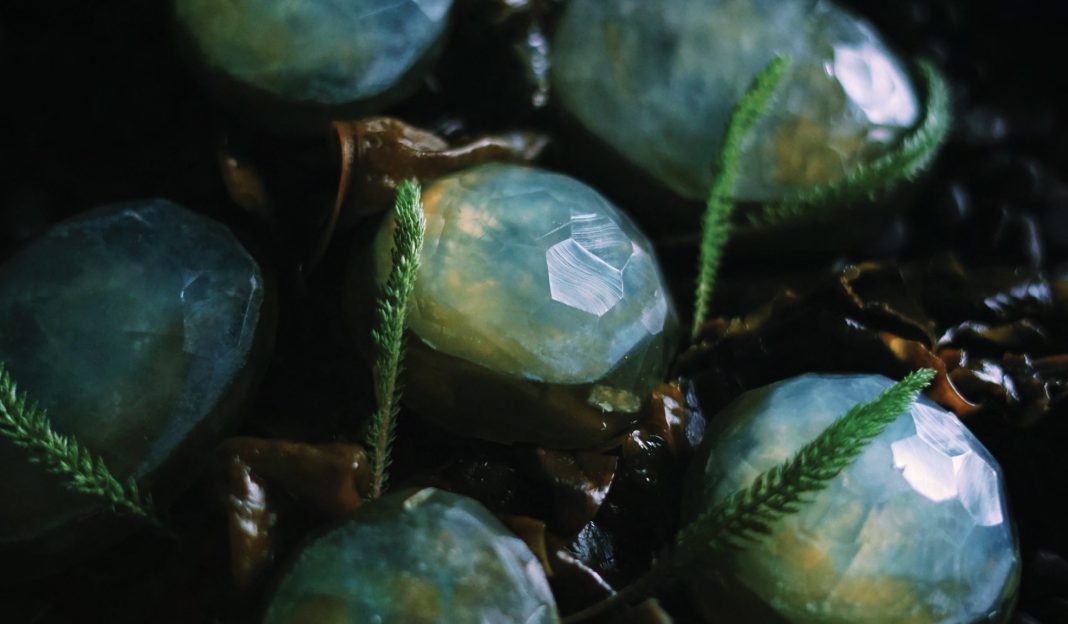This soap is an ode to the dancing of underwater light, the shimmering of sunlight filtering through kelp forests and the gray depths that stretch far beyond our reach. It is also an ode to labradorite, the stone that perfectly captures the ephemeral luminescence of such a magical realm.
Kelp is a large brown seaweed that grows in underwater forests in shallow ocean. It’s very rich in vitamins and minerals to nourish the skin as you use this soap—plus it gives it a nice opaque green color. It is also known to help regulate glands and hormones as well as cleansing the body of iodine. There’s not enough in this soap to make a noticeable difference, but it does give it a beautiful color and subtle ocean scent!
Yarrow is one of the most well-known healing herbs and can be found all over the world. I often find it growing above the high-tide mark on the seashore, but it is also found in forests, meadows, and even coming up through city sidewalks. It is thought to be helpful in addressing allergies and rashes, and in promoting healing in slow-healing wounds. Its spicy scent is the perfect counterbalance to the kelp. It also has the added benefit of adding a slight blue tint to this soap naturally, as yarrow essential oil is bright blue.

Yarrow Kelp Labradorite Soap
Makes about eight bars.
Recipe can easily be halved if desired.
Before you make this recipe, you’ll need to make yarrow-infused oil. This takes some time, so if you’re in a hurry you can just use regular jojoba oil or purchase yarrow oil from Mountain Rose Herbs. A note: Yarrow oil and yarrow essential oil are not the same and shouldn’t be used interchangeably. Yarrow oil is just a carrier oil (like olive or jojoba) infused with the essence of yarrow. Yarrow essential oil consists of the volatile oils in the plant itself distilled into a highly concentrated solution.
To make the infused oil, harvest some fresh yarrow leaves. Wash, then dry well and leave out for a couple of hours to partially dry. Fill a small jar about three-quarters full with the wilted yarrow leaves, then top with an oil of your choice. Jojoba or grapeseed is particularly nice in soaps, but olive oil works great too with the added benefit of being edible. Yarrow oil is fantastic in salad dressings and drizzled over bread or roasted vegetables. Let the oil sit in a warm, dark place for four to six weeks, then strain.
Ingredients:
Mix One:
1 lb. glycerin
1 tsp. yarrow oil
4 drops yarrow essential oil
15 drops grapefruit essential oil
Mix Two:
1 lb. glycerin
¼ tsp. kelp
1 tsp. yarrow oil
15 drops yarrow essential oil
10 drops grapefruit essential oil
10 drops lavender essential oil
Other:
A little extra glycerin
¼ tsp. gold mica powder
¼ tsp. silver mica powder
¼ tsp. blue mica powder
Half-sphere soap molds
Spray bottle full of rubbing alcohol Using a large knife, cut the soap into cubes, then melt the first batch in a couple boiler, covering the double boiler with the lid. You can also melt your soap in the microwave by placing it in a microwave-safe glass measuring cup and covering it with plastic wrap (to keep the moisture from escaping). Use the 50 percent setting and stir every couple of minutes until nearly all the soap has melted. Remove from the microwave and let sit until the rest of the soap melts, keeping it covered. Stir gently and be careful not to introduce bubbles.
Once the soap is melted, remove the bowl from heat. Let cool slightly, until it is under 140°F, then transfer it to a heat-proof pouring container, like a Pyrex measuring cup. Add the rest of the ingredients from Mix One and stir gently until well combined. Then pour into the soap molds, filling them halfway or so. Spritz the tops with rubbing alcohol to prevent bubbles and allow the soaps to set up. Reserve a little bit of the soap mixture for the next step.
Melt the small amount of reserved soap and allow to cool slightly. Divide it into three heat-safe pourable containers. In each container, mix in one of the luster dusts. Spray the surface of the already-set soap with rubbing alcohol, then pour a very small amount of the gold-infused soap on top. Then add some silver and blue next to it. With a clean paintbrush, mix them with each other just a little bit with a swirling motion—you want them to remain separate but overlap a little bit. Try to keep your total amount of soap on each bar down to about an eighth of an inch thick or even thinner. Mist with rubbing alcohol, and allow to set up.
Once the luster layer has set up, cut some lines into the top using a sharp knife to give the finished product an authentic labradorite look. You’ll want to cut all the way through the luster in some areas if possible.
Repeat the soap-melting process with the remaining soap and any leftover soap from the previous step. Allow it to cool slightly so that it thickens but does not form a skin. While it’s cooling, mix the kelp and the yarrow oil in a small separate bowl. Blend until lump-free and creamy. Add to the melted soap, along with the other ingredients listed for Mix Two. Stir gently, so as not to introduce bubbles, until the soap is a consistent dark teal color and all the oils have been absorbed into the solution.
Spritz the top of the set soaps with rubbing alcohol, then fill the molds the rest of the way with the melted soap. Spritz the top again and let it set up completely. Repeat the process with the rest of the soap. Allow the soap to cool and fully harden, then remove from the molds onto a wax-paper-covered surface. Cover it with more wax paper and a kitchen towel and let sit for twenty-four hours.
If you’d like, you can carve facets into your “stones” using a sharp kitchen knife. Polish with a soft cloth afterward. Your soap is now ready to use! To store or give as gifts, wrap your soap in plastic cling wrap to keep moisture in and store in a dark place, like a closet.



































